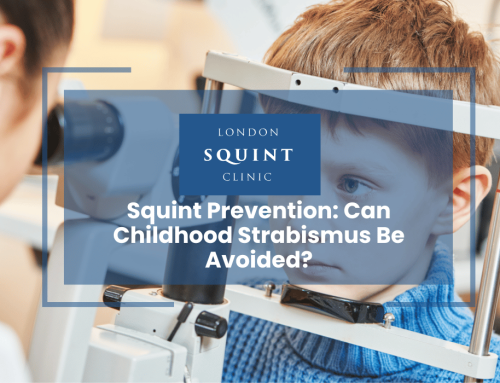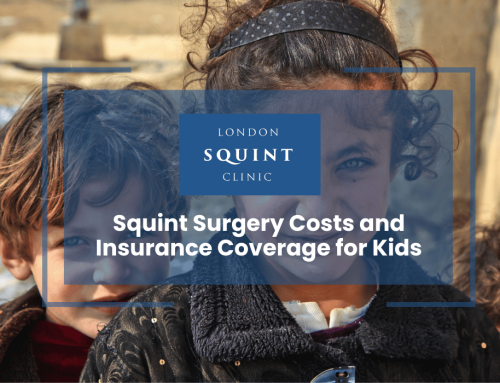Squint in Newborns: When Eyes Don’t Align Properly
What Every Parent Should Know About Newborn Squint
- Newborn squint, or congenital strabismus, is a condition where a baby’s eyes are misaligned from birth, with one or both eyes turning inward, outward, up, or down.
- Common signs of squint in infants include constant eye misalignment, head tilting, squinting, and poor depth perception.
- While intermittent misalignment is common in newborns up to 4 months old, persistent or pronounced eye turning warrants evaluation by a pediatric ophthalmologist.
- Prompt diagnosis and early intervention, often by 6-12 months of age, provide the best opportunity for successful treatment and normal visual development.
- Treatment options may include glasses, eye patching, exercises, or surgery, depending on the type and severity of the squint.
- With proper treatment and follow-up care, most children with congenital strabismus can achieve good visual outcomes and avoid long-term complications.
- Parents play a crucial role in supporting their baby’s treatment by following the prescribed plan, encouraging vision development, and staying positive throughout the process.
Here is the blog post content with the requested sections and formatting:
Table of Contents
- What Is Newborn Squint and Why Does It Occur?
- Identifying Signs of Squint in Infants: What to Look For
- When Do Babies’ Eyes Normally Start Aligning Properly?
- Types of Congenital Strabismus in Newborns
- Diagnosing Squint: Pediatric Eye Exams for Infants
- Treatment Options for Newborn Eye Misalignment
- Long-Term Outlook and Importance of Early Intervention
- Coping with Your Baby’s Squint: Tips for Parents
What Is Newborn Squint and Why Does It Occur?
Newborn squint, also known as congenital strabismus, is a condition where a baby’s eyes are not properly aligned from birth. One or both eyes may turn inward, outward, up, or down, while the other eye looks straight ahead. This misalignment occurs due to abnormal development of the eye movement control center in the brain or imbalance of the eye muscles. In some cases, squint may be caused by more serious conditions affecting the eye, brain, or general health. Congenital strabismus is different from intermittent misalignment that is common in newborns up to 4 months old, as it is constant and usually more pronounced. Prompt evaluation by a pediatric ophthalmologist is crucial for proper diagnosis and treatment planning.
Identifying Signs of Squint in Infants: What to Look For
Parents are often the first to notice signs of squint in their newborn. Common indications that a baby may have congenital strabismus include:
- One or both eyes constantly turning inward, outward, up, or down
- Misaligned eyes more noticeable when baby is tired, ill, or focusing on near objects
- Tilting or turning head to look at things
- Squinting or closing one eye, especially in bright light
- Poor depth perception or hand-eye coordination
If you notice any of these signs in your newborn, it’s important to schedule an evaluation with a pediatric ophthalmologist. They can perform a comprehensive eye exam to determine if congenital strabismus is present and recommend an appropriate treatment plan. Early diagnosis and intervention provide the best opportunity for successful alignment and visual development.
When Do Babies’ Eyes Normally Start Aligning Properly?
Newborn babies often have intermittent crossed eyes or misalignment, especially when tired or focusing on near objects. This is because the eye movement control center in the brain is still developing, and the eyes are learning to work together. In most cases, this intermittent misalignment resolves on its own by 3-4 months of age as the baby’s visual system matures. However, if the eye crossing is constant, frequently recurring, or one eye turns significantly more than the other, it may indicate true congenital strabismus. Persistent eye misalignment beyond 4 months of age warrants an evaluation by a pediatric ophthalmologist to rule out underlying conditions and initiate appropriate treatment if needed.
Types of Congenital Strabismus in Newborns
Congenital strabismus can manifest in different ways depending on which direction the eye or eyes are misaligned. The main types of strabismus seen in newborns include:
- Esotropia: One or both eyes turn inward towards the nose
- Exotropia: One or both eyes turn outward away from the nose
- Hypertropia: One eye turns upward
- Hypotropia: One eye turns downward
Some babies may have a combination of these misalignments or the deviation may alternate between eyes. Infantile esotropia is the most common type of congenital strabismus, where a large inward turn of one or both eyes is constantly present within the first 6 months of life. A pediatric ophthalmologist can determine the specific type and severity of strabismus through a comprehensive eye exam.
Diagnosing Squint: Pediatric Eye Exams for Infants
If congenital strabismus is suspected, it’s crucial to have the baby’s eyes examined by a pediatric ophthalmologist. They are specially trained to evaluate eye health and alignment in infants and young children. During the exam, the ophthalmologist will:
- Check the baby’s vision and eye movements
- Assess eye alignment using light reflex tests and cover/uncover tests
- Examine the front and back of the eye for any structural abnormalities
- Measure refractive error to determine if glasses are needed
- Evaluate for any associated conditions like amblyopia or nystagmus
Special techniques and equipment are used to obtain accurate measurements while keeping the baby comfortable. The ophthalmologist may also use dilating eye drops to get a better view of the back of the eye. Based on the exam findings, they can diagnose congenital strabismus and recommend an appropriate treatment plan to align the eyes and promote proper visual development.
Treatment Options for Newborn Eye Misalignment
Treatment for congenital strabismus depends on the type, severity, and underlying cause of the misalignment. In some cases, the ophthalmologist may recommend monitoring the condition for a few months to see if it resolves on its own as the baby’s visual system develops. If treatment is necessary, options may include:
- Glasses to correct significant refractive errors contributing to eye turn
- Eye patching or blurring to treat amblyopia (lazy eye) that may develop in the misaligned eye
- Eye exercises or prisms to help the eyes work together
- Eye muscle surgery to physically realign the eyes if non-surgical methods are ineffective
Treatment is usually started as early as possible, often by 6-12 months of age, to maximize the chance of successful alignment and visual development. In some cases, multiple treatment methods may be combined for optimal results. The pediatric ophthalmologist will customize the treatment plan based on the individual needs of the baby and family, with the goal of providing the best possible visual outcome.
Long-Term Outlook and Importance of Early Intervention
The long-term outlook for newborns with congenital strabismus depends on the underlying cause, severity of misalignment, and timing of treatment. Early diagnosis and intervention are crucial for achieving the best possible outcome. When treated promptly and appropriately, many babies with congenital strabismus can develop normal vision and eye alignment. However, delaying treatment can lead to permanent vision problems like amblyopia, loss of depth perception, and cosmetic concerns. In some cases, eye muscle surgery may be necessary to correct the misalignment if non-surgical methods are ineffective. Even after successful treatment, ongoing monitoring by a pediatric ophthalmologist is important to ensure the eyes remain straight and vision continues to develop properly. With proper care and follow-up, most children with congenital strabismus can achieve good visual outcomes and avoid long-term complications.
Coping with Your Baby’s Squint: Tips for Parents
Learning that your newborn has congenital strabismus can be concerning and overwhelming. Here are some tips to help you cope and support your baby’s treatment:
- Educate yourself about the condition and treatment options
- Attend all scheduled appointments with the pediatric ophthalmologist
- Follow the prescribed treatment plan carefully, including patching or glasses wear
- Encourage your baby’s vision development with age-appropriate toys and activities
- Be patient and positive, as improvement may be gradual
- Celebrate your baby’s progress and milestones
- Seek support from family, friends, or support groups
- Remember that with proper treatment, most babies with congenital strabismus can achieve good visual outcomes
Your pediatric ophthalmologist is your partner in caring for your baby’s eyes. Don’t hesitate to ask questions, express concerns, or seek guidance throughout the treatment process. With your love, support, and dedication to treatment, your baby can thrive and enjoy a lifetime of healthy vision.
Frequently Asked Questions
What causes a newborn baby’s eyes to be crossed?
Crossed eyes in newborns, known as congenital strabismus, can be caused by abnormal development of the eye movement control center in the brain or an imbalance of the eye muscles. In some cases, it may be due to more serious conditions affecting the eye, brain, or general health.
How can I tell if my baby has strabismus?
Signs that your baby may have strabismus include one or both eyes constantly turning inward, outward, up, or down; misaligned eyes that are more noticeable when the baby is tired, ill, or focusing on near objects; tilting or turning the head to look at things; squinting or closing one eye; and poor depth perception or hand-eye coordination.
When should I be concerned about my newborn’s eye misalignment?
You should be concerned about your newborn’s eye misalignment if it is constant, frequently recurring, or one eye turns significantly more than the other. Persistent eye misalignment beyond 4 months of age warrants an evaluation by a pediatric ophthalmologist to rule out underlying conditions and initiate appropriate treatment if needed.
How is congenital strabismus diagnosed in infants?
Congenital strabismus is diagnosed through a comprehensive eye exam by a pediatric ophthalmologist. The exam includes checking the baby’s vision and eye movements, assessing eye alignment using light reflex tests and cover/uncover tests, examining the front and back of the eye for any structural abnormalities, measuring refractive error, and evaluating for associated conditions like amblyopia or nystagmus.
What treatments are available for newborn eye misalignment?
Treatment options for newborn eye misalignment depend on the type, severity, and underlying cause of the condition. Non-surgical treatments may include glasses to correct refractive errors, eye patching or blurring to treat amblyopia, eye exercises, or prisms. In some cases, eye muscle surgery may be necessary to physically realign the eyes if non-surgical methods are ineffective.
Can congenital strabismus be cured?
While congenital strabismus cannot always be completely cured, early diagnosis and appropriate treatment can significantly improve eye alignment and visual development. Many babies with congenital strabismus can achieve normal vision and eye alignment with prompt and proper care. However, ongoing monitoring by a pediatric ophthalmologist is important to ensure the best possible outcome.
What can I do to help my baby with strabismus?
To help your baby with strabismus, educate yourself about the condition and treatment options, attend all scheduled appointments with the pediatric ophthalmologist, follow the prescribed treatment plan carefully, encourage your baby’s vision development with age-appropriate toys and activities, be patient and positive, celebrate your baby’s progress, and seek support from family, friends, or support groups.
Find out if you are suitable for Double Vision Treatment
Not everyone is eligible for double vision surgery.
Find out if you could benefit from this life-changing surgery by taking the quick self-suitability quiz below:
Our most popular procedures

Hello, I’m Nadeem Ali
I’m one of the few eye surgeons in the world with 100% focus on Squint and Double Vision Surgery.
I have 24 years of eye surgery experience, and worked for 13 years as a Consultant at London’s renowned Moorfields Eye Hospital.
In 2023, I left the NHS to focus fully on treating patients from across the world at the London Squint Clinic. You can read more about me here.
There’s lots of information on the website about: squint surgery, double vision surgery and our pricing.
The most rewarding part of my job is hearing patients tell me how squint or double vision surgery has changed their lives. You can hear these stories here.
Mr Nadeem Ali
MA MB BChir MRCOphth FRCSEd(Ophth)





